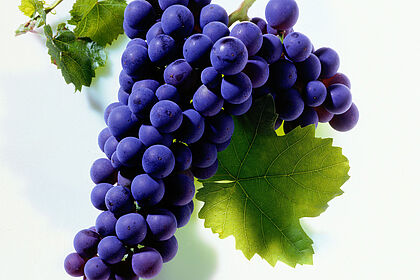レンベルガー|Lemberger
赤ワイン品種
Lemberger - spreads southern warmth
Lemberger, also known as "Blauer Limberger" and "Blaufränkisch" grows in a warm climate and wind-protected areas, since bud-burst is early and it ripens late. In very good sites, this Württemberg speciality yields wines with excellent quality. It does well in various soil types, especially fertile, deep, loess-loam soils.
For years we have been seeing a gradual but steady increase in the area under vines for Lemberger. It has expanded from 500 ha in 1970 to 1,900 ha in 2019. It is almost exclusively cultivated in Württemberg, where it accounts for about 16% of the total vineyard area compared with 1,9% in Germany overall.

Lemberger
Viniculture/Taste
For wine connoisseurs, Lemberger is a “coat of many colors”.....ranging from light and fruity wines to those that are rich in extract and tannin (of Spätlese and Auslese ripeness). Usually, the wines are extremely dark in color. The bouquet can range from rather quiet to powerful, reminiscent of blackberries, sweet or sour cherries, plums, currants, gooseberries, elderberries, bananas and chocolate, as well as vegetal aromas, such as green beans or green bell peppers. Depending on vinification techniques, the wines have a fruity or a tannic accent and a long finish. Thanks to their acid, extract and tannin profile, even drier versions of Lemberger have good aging potential. Barrique-aging adds another dimension...reminiscent of Mediterranean warmth and charm. Ambitious vintners and cooperatives often blend Lemberger with Trollinger (depending on the percentage of the cuvée's components, the wine will be labeled with the predominant variety named first). Sparkling wine, or Sekt, made from the Lemberger grape is a real speciality.
History
Officially classified under the name “Blauer Limberger”, this red grape variety also goes by the synonyms “Lemberger” and “Blaufränkisch”. The late-ripening Lemberger probably originated in vineyards on the lower stretches of the Danube River. The grape was documented in Austria in the second half of the 18th century and is cultivated there to this day (as Blaufränkisch) in Burgenland and near Vienna. In Hungary it is known as Kékfrankos. In the 19th century a “wine improvement society” advocated replacing high-yielding varieties with high-quality grapes (such as Lemberger) in the Kingdom of Württemberg. Indeed, Lemberger wines from Württemberg were the favorite of the first president of the Federal Repubic of Germany, Theodor Heuss, and it is said that the variety was equally as popular with Bismarck and Napoleon.
